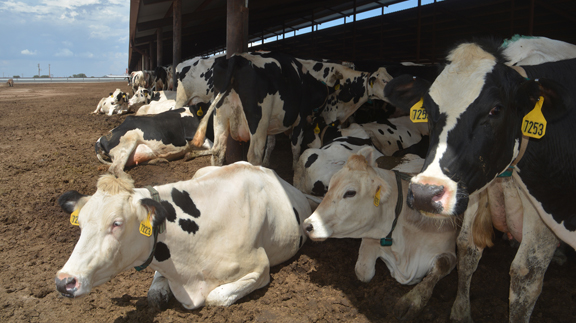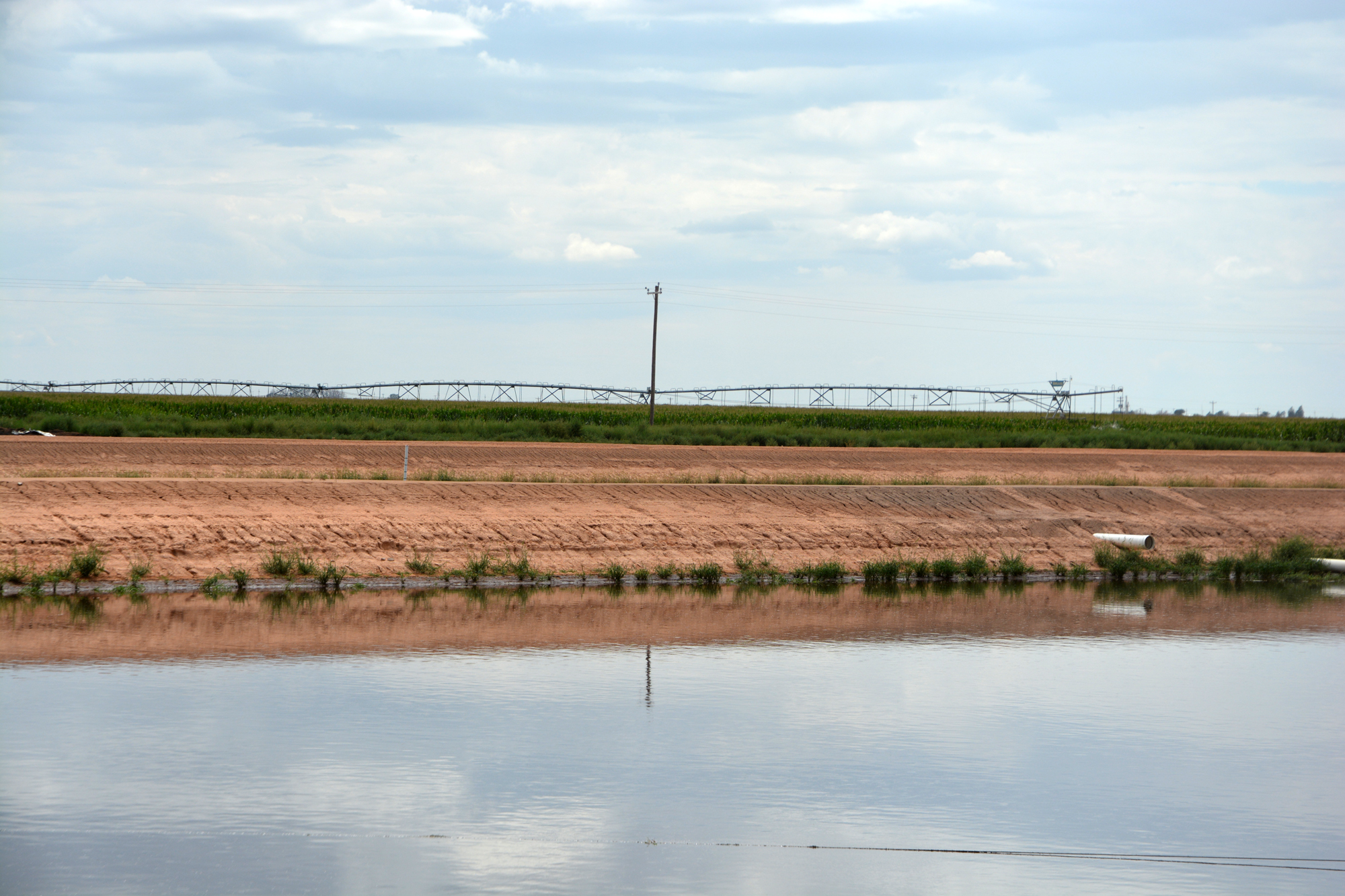Farm & Ranch
[AgriLife Today] Water a major concern for dairy industry

By: Kay Ledbetter
High Plains conference provides management advice, weather outlook
Writer: Kay Ledbetter, 806-677-5608, [email protected]
Contacts: Dr. Ellen Jordan, 972-952-9212, [email protected]
Dr. Dana Porter, 806-746-6101, [email protected]
LUBBOCK – Water is a continuous concern for dairy producers, whether used for cows or crops, and management information was shared with those attending the recent High Plains Dairy Conference in Lubbock.
“Our dairy producers are very concerned about how much water they use, both for the cows and the crops they produce,” said Dr. Ellen Jordan, Texas A&M AgriLife Extension Service dairy specialist in Dallas and coordinator of the program.
The High Plains Dairy Conference was open to dairy producers from Colorado, Kansas, Oklahoma and New Mexico, in addition to Texas, Jordan said. Approximately 280 people attended this year’s conference.
“These dairy producers are looking for ways to conserve water throughout their facilities and farmland,” she said. “They are also very interested in the weather and forecast, not only for their crops but so they can manage the environment for the comfort of their cows.”
Dr. Dana Porter, AgriLife Extension agricultural engineering water management specialist in Lubbock, told the crowd the first thing they need to do is familiarize themselves with all of the water information resources, including the Texas Water Development Board, local groundwater districts, the U.S. Geological Society or their state Extension service.

Water is important for both crops and cows on a dairy. (Texas A&M AgriLife Communications photo by Kay Ledbetter)
These are good sources for information concerning water supply, demand, development, saturated thickness, water quality and the history for water on any given property, Porter said.
“They can let you see if salinity is likely to be a problem, and what the alternate sources of water might look like in secondary aquifers,” she said. “Just remember these local, regional, state and federal resources have a lot of answers for you.”
Porter also talked about managing their water through irrigation technologies.
“What fits best and what works best depends on each operation,” she said.
Key concerns when selecting the right irrigation system, Porter said, will be water capacity, field layout, crop rotation, management and labor, energy availability and economic feasibility.
“The challenge is to maintain productivity or increase it with limited water resources,” she said. “Advanced technology is available, but it is important to understand the best management practices to help mitigate the effects of declining water resources and adoption of the appropriate technologies.
“Regardless of our tool selection, we want to make sure we manage and maintain our irrigation system well, and have accurate knowledge of crop water requirements and soil-water-atmosphere relationships,” Porter said.
Additionally, dairy producers, especially in the High Plains, need to know what alternative water sources they have, such as the Dockum aquifer, and be able to address the salinity concerns that may come with using that water.
They will need to know about salt-tolerant crops and protecting equipment from chemical precipitation and corrosion, she said, as well as the drinking water quality for the animals and concerns if there is too much salt content.
Overall, she said, a lot of resources are dedicated to collecting and disseminating information about water supplies. Producers should take advantage of the information available.
John Nielsen-Gammon’s message to the dairy producers was one of “what’s next” in the way of weather. Nielsen-Gammon is the state climatologist and Regents Professor at Texas A&M University, College Station.
“We have lots of people asking what happened to El Nino,” Nielson-Gammon said. “We’ve had areas that have been extremely wet while others have been dry and spotty. Kansas and Colorado along with parts of Oklahoma are extremely dry. It’s been a quite variable year.”
The current El Nino is the third strongest on record. But he pointed out that what has happened with the strongest two El Ninos is not the same as if the top 12 are averaged.
Looking back at past El Ninos, the two stronger ones were both associated with wetter than normal conditions along the coasts and drier conditions through the middle of the U.S. Others were associated with much wetter conditions across Texas and the surrounding states.
The top 12 strongest show that moisture typically begins picking up in March in this region, Nielson-Gammon said. It will vary from month to month on any given El Nino, but most follow a similar pattern.
“We never really get a super wet January or February,” he said. “In the overall pattern going forward, we’re not sure which category this El Nino is going to fall into. We can expect an average of an additional inch or so of rainfall when you look at the top 12.”
Computer models at this time are indecisive, not showing any area particularly wetter or drier than normal, Nielson-Gammon said, “So there’s equal chances it could go either way.”
“Right now,” he said, “there are no good useful forecasts of summer rainfall. It looks like we can expect much of the nation to be warmer than normal. Summer, therefore, is a toss-up.”
Jordan said producers watch both short and long-term forecasts to know how to allocate their labor and corral management.
-30-
LikeTweet
Find more stories, photos, videos and audio at http://today.agrilife.org
Farm & Ranch
Acorn Toxicity

By Barry Whitworth, DVM, MPH
With the prolonged drought, most pastures in Oklahoma end up in poor condition. With the lack of available forage, animals may go in search of alternative foods.
If oak trees are in the pastures, acorns may be a favorite meal for some livestock in the fall. This may result in oak poisoning.
Oak leaves, twigs, buds, and acorns may be toxic to some animals when consumed.
To read more, pick up a copy of the November edition of North Texas Farm & Ranch magazine, available digitally and in print. To subscribe by mail, call 940-872-5922.

Farm & Ranch
Silver Bluestems

By: Tony Dean
There are a handful of grasses on North Texas grazing lands ranchers need to know, not because they are highly desirable, but rather because they are not of much value. I call them “decom” plants, which is am acronym for “Don’t Ever Count On Me.” Silver bluestem is a “decom” grass.
Silver bluestem is a perennial which grows in all areas of Texas. It can survive in almost all soil types, and in full sun conditions or in semi shade. It grows up to three feet tall and is easily recognized with the presence of the white fuzzy seed head. Also, one of the identifying characteristics of Silver bluestem is a bend in the stems at each node, causing the plants to take on a rounded shape as they mature.
To read more, pick up a copy of the November edition of North Texas Farm & Ranch magazine, available digitally and in print. To subscribe by mail, call 940-872-5922.

Farm & Ranch
Meanwhile Back At The Ranch

By: Rayford Pullen
Fall is here which means winter is closing in on us and before we officially get into winter, we need to make sure our factories are either producing or will be producing in a few months.
We have been pregnancy testing our cows this fall and if they are not bred or nursing a calf, we are bidding them adios. With annual costs somewhere between $900.00 and $1,000.00 per cow, those cows not producing a live weaned calf are costing us quite a bit.
To read more, pick up a copy of the November edition of North Texas Farm & Ranch magazine, available digitally and in print. To subscribe by mail, call 940-872-5922.
-

 Country Lifestyles2 years ago
Country Lifestyles2 years agoScott & Stacey Schumacher: A Growth Mindset
-

 Country Lifestyles8 years ago
Country Lifestyles8 years agoStyle Your Profile – What your style cowboy hat says about you and new trends in 2017
-

 HOME8 years ago
HOME8 years agoGrazing North Texas – Wilman Lovegrass
-

 Equine1 year ago
Equine1 year agoThe Will to Win
-

 Country Lifestyles5 years ago
Country Lifestyles5 years agoAmber Crawford, Breakaway Roper
-

 Outdoor9 years ago
Outdoor9 years agoButtercup or Primrose?
-

 Country Lifestyles8 years ago
Country Lifestyles8 years agoJune 2016 Profile – The man behind the mic: Bob Tallman
-

 Country Lifestyles8 years ago
Country Lifestyles8 years agoDecember 2016 Profile, Rusty Riddle – The Riddle Way





